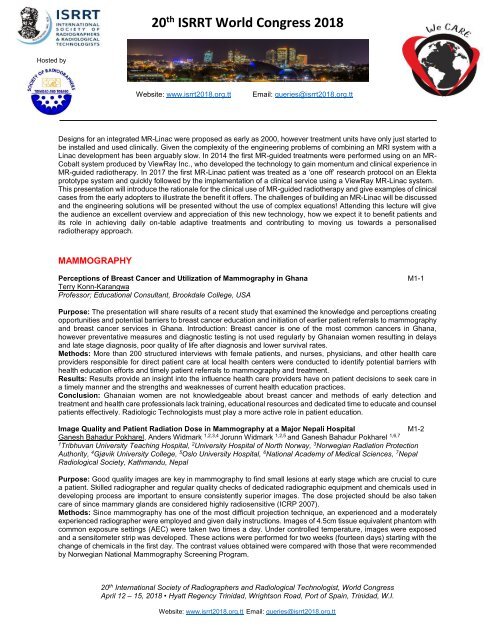Trinidad-and-Tabago-Congerss-Abstract-Book
You also want an ePaper? Increase the reach of your titles
YUMPU automatically turns print PDFs into web optimized ePapers that Google loves.
20 th ISRRT World Congress 2018<br />
Hosted by<br />
Website: www.isrrt2018.org.tt<br />
Email: queries@isrrt2018.org.tt<br />
Designs for an integrated MR-Linac were proposed as early as 2000, however treatment units have only just started to<br />
be installed <strong>and</strong> used clinically. Given the complexity of the engineering problems of combining an MRI system with a<br />
Linac development has been arguably slow. In 2014 the first MR-guided treatments were performed using on an MR-<br />
Cobalt system produced by ViewRay Inc., who developed the technology to gain momentum <strong>and</strong> clinical experience in<br />
MR-guided radiotherapy. In 2017 the first MR-Linac patient was treated as a ‘one off’ research protocol on an Elekta<br />
prototype system <strong>and</strong> quickly followed by the implementation of a clinical service using a ViewRay MR-Linac system.<br />
This presentation will introduce the rationale for the clinical use of MR-guided radiotherapy <strong>and</strong> give examples of clinical<br />
cases from the early adopters to illustrate the benefit it offers. The challenges of building an MR-Linac will be discussed<br />
<strong>and</strong> the engineering solutions will be presented without the use of complex equations! Attending this lecture will give<br />
the audience an excellent overview <strong>and</strong> appreciation of this new technology, how we expect it to benefit patients <strong>and</strong><br />
its role in achieving daily on-table adaptive treatments <strong>and</strong> contributing to moving us towards a personalised<br />
radiotherapy approach.<br />
MAMMOGRAPHY<br />
Perceptions of Breast Cancer <strong>and</strong> Utilization of Mammography in Ghana M1-1<br />
Terry Konn-Karangwa<br />
Professor; Educational Consultant, Brookdale College, USA<br />
Purpose: The presentation will share results of a recent study that examined the knowledge <strong>and</strong> perceptions creating<br />
opportunities <strong>and</strong> potential barriers to breast cancer education <strong>and</strong> initiation of earlier patient referrals to mammography<br />
<strong>and</strong> breast cancer services in Ghana. Introduction: Breast cancer is one of the most common cancers in Ghana,<br />
however preventative measures <strong>and</strong> diagnostic testing is not used regularly by Ghanaian women resulting in delays<br />
<strong>and</strong> late stage diagnosis, poor quality of life after diagnosis <strong>and</strong> lower survival rates.<br />
Methods: More than 200 structured interviews with female patients, <strong>and</strong> nurses, physicians, <strong>and</strong> other health care<br />
providers responsible for direct patient care at local health centers were conducted to identify potential barriers with<br />
health education efforts <strong>and</strong> timely patient referrals to mammography <strong>and</strong> treatment.<br />
Results: Results provide an insight into the influence health care providers have on patient decisions to seek care in<br />
a timely manner <strong>and</strong> the strengths <strong>and</strong> weaknesses of current health education practices.<br />
Conclusion: Ghanaian women are not knowledgeable about breast cancer <strong>and</strong> methods of early detection <strong>and</strong><br />
treatment <strong>and</strong> health care professionals lack training, educational resources <strong>and</strong> dedicated time to educate <strong>and</strong> counsel<br />
patients effectively. Radiologic Technologists must play a more active role in patient education.<br />
Image Quality <strong>and</strong> Patient Radiation Dose in Mammography at a Major Nepali Hospital M1-2<br />
Ganesh Bahadur Pokharel, Anders Widmark 1,2,3,4 Jorunn Widmark 1,2,5 <strong>and</strong> Ganesh Bahadur Pokharel 1,6,7<br />
1 Tribhuvan University Teaching Hospital, 2 University Hospital of North Norway, 3 Norwegian Radiation Protection<br />
Authority, 4 Gjøvik University College, 5 Oslo University Hospital, 6 National Academy of Medical Sciences, 7 Nepal<br />
Radiological Society, Kathm<strong>and</strong>u, Nepal<br />
Purpose: Good quality images are key in mammography to find small lesions at early stage which are crucial to cure<br />
a patient. Skilled radiographer <strong>and</strong> regular quality checks of dedicated radiographic equipment <strong>and</strong> chemicals used in<br />
developing process are important to ensure consistently superior images. The dose projected should be also taken<br />
care of since mammary gl<strong>and</strong>s are considered highly radiosensitive (ICRP 2007).<br />
Methods: Since mammography has one of the most difficult projection technique, an experienced <strong>and</strong> a moderately<br />
experienced radiographer were employed <strong>and</strong> given daily instructions. Images of 4.5cm tissue equivalent phantom with<br />
common exposure settings (AEC) were taken two times a day. Under controlled temperature, images were exposed<br />
<strong>and</strong> a sensitometer strip was developed. These actions were performed for two weeks (fourteen days) starting with the<br />
change of chemicals in the first day. The contrast values obtained were compared with those that were recommended<br />
by Norwegian National Mammography Screening Program.<br />
20 th International Society of Radiographers <strong>and</strong> Radiological Technologist, World Congress<br />
April 12 – 15, 2018 • Hyatt Regency <strong>Trinidad</strong>, Wrightson Road, Port of Spain, <strong>Trinidad</strong>, W.I.<br />
Website: www.isrrt2018.org.tt Email: queries@isrrt2018.org.tt


















